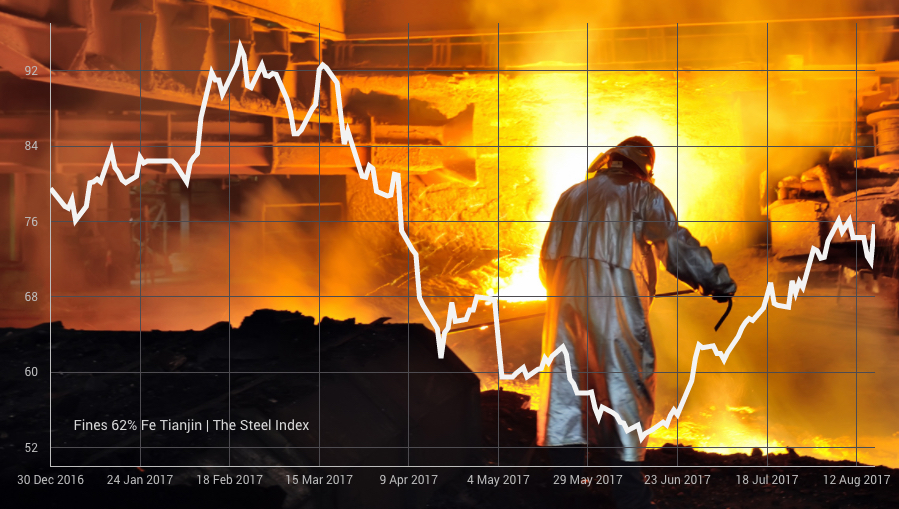 After a string of down days, the Northern China import price of 62% Fe content ore bounced back on Thursday. According to data supplied by The Steel Index the steelmaking raw material jumped 5.6% to exchange hands for $75.70 per dry metric tonne, not far off 4-month highs hit last week.
After a string of down days, the Northern China import price of 62% Fe content ore bounced back on Thursday. According to data supplied by The Steel Index the steelmaking raw material jumped 5.6% to exchange hands for $75.70 per dry metric tonne, not far off 4-month highs hit last week.
The iron ore price is now trading up a whopping 43% from its 2017 lows struck just two months ago as Chinese anti-pollution crackdown on its heavy industries force the country’s steelmakers to chase high quality imports.
Iron ore’s latest rally comes after another furious day of trading on ferrous derivates markets in China. Regulators hiked fees and imposed trading limits last week to dampen speculative activity leading to a slump in prices for steel, iron ore and coking coal but on Thursday the bulls were charging again.
In Shanghai rebar futures – the world’s most traded steel contract – gained over 3% to within shouting distance of 4½-year highs while Dalian coking coal futures surged by its 8% daily uplimit to hit a record high and iron ore advanced as much as 7%.
Premiums for lump rose to just under 18c per tonne (a more than $11 premium over spot prices) after hitting an all time low of just 1.5c in April
China’s steel production last month rose more than 10% compared to last year to a record 74m tonnes as traders worry about a steel supply crunch going into the new year. Beijing wants to cut output by as much as 50% during winter months to fight smog, particularly in its capital city and surrounding areas.
In Hebei province, China’s key producing region, steelmakers have until September 1 to comply with stringent new emissions regulations or would be shut down. Some 120 million tonnes of low-quality steel capacity were shuttered during the first six month of the year.
Beijing’s policies to clean up and consolidate the domestic steel industry is playing into the hands of iron ore exporting countries. Low grade furnaces – particularly those that use scrap – have been outlawed and authorities are also clamping down on sintering plants.
Sintering is a necessary extra step when using low grade ore (domestic Chinese iron content averages only about 20%) and pelletizing plants using fines or iron ore concentrates have also been fingered as polluters by Beijing.
Fines drive the iron ore price and it makes up the bulk of supply, but producers of so-called “lump” ore enjoy a little more breathing room.
Lump ore can be loaded directly into blast furnaces, is easier to handle during transportation and can be shipped during wet seasons (liquefaction can be an issue with the shipment of iron ore fines during wet weather). For steelmakers it cuts pollution and lowers cost and lump now constitutes between 15%–20% of blast furnace feedstock.
Platts reports premiums for lump rose to just under 18c per dry tonne unit (which translates to around a $11.25 premium over spot prices) after hitting an all time low of just 1.5c in April this year. Open interest – a measure of market participation – on physical lump premium contracts trading in Singapore hit an all-time high last month.